| Page last updated
23 December 2007 |
MUSSELp in Zambia 2007: Observations
DLG left for Zambia on 13 May and returned to Philadelphia on 3 June 2007. The objective of the trip was to undertake a collecting expedition to the upper Congo Basin in collaboration with Alex Chilala. That was successful, and a report of our collecting localities can be found by clicking here. Such trips also provide an opportunity for extra-malacological personal growth. The purpose of this page is to share some personal observations from southern Africa.
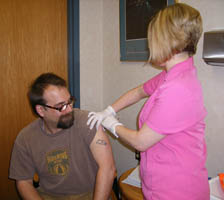 Pre-Trip Preparations Pre-Trip Preparations
This trip to Africa was unique for me because it required very little preparation, relative to my other expeditions. I have accumulated most of the necessary supplies and equipment already, and my packing checklist has been revised to the point of near-perfection. Also, I was working closely a friend in-country, Alex Chilala, who was invaluable in his efforts to make sure things went smoothly.
For the most part, my vaccinations were up to date as well, but I did need a meningitis booster. The picture to the right shows me with my regular jab-giver, Carly. |
Transportation
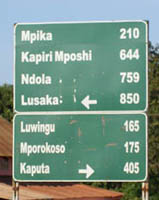 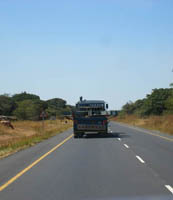 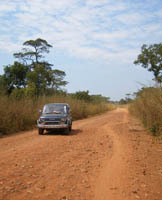
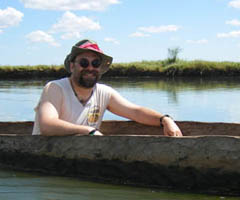 The road sign above represents our trip well. We drove from Lusaka, through Kapiri Mposhi and Mpika, to Kasama (where the sign was posted). From Kasama, we went via Mporokoso to Kaputa, and thence to Nchelenge, Mansa and back to Lusaka. The road sign above represents our trip well. We drove from Lusaka, through Kapiri Mposhi and Mpika, to Kasama (where the sign was posted). From Kasama, we went via Mporokoso to Kaputa, and thence to Nchelenge, Mansa and back to Lusaka.
We drove a over 5000 km in our rented Land Cruiser. Zambia has many excellent paved roads, but a long portion of our journey (especially the 405 km from Kasama to Kaputa) was on terrible dirt road. Moreover, filling stations were widely spaced, forcing us to carry extra, smelly diesel.
Occasionally, we had the opportunity to travel by boat. |
Lodging
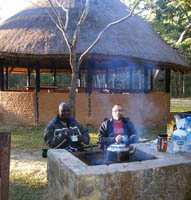 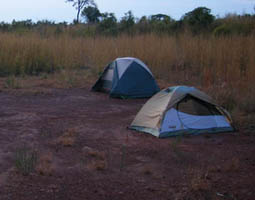
In the southern and eastern parts of Zambia, where tourism is more common, campgrounds are very common. It is generally inexpensive to pitch a tent within a walled compound, where you can either purchase firewood to cook for yourself or just go the the restaurant. However, in northern Zambia, such facilities are less common, and for the most part, Alex and I stayed indoors. One night, near the far northern town of Kaputa, we found a good bush camp near a gravel pit.
I prefer camping when it is safe to do so. When settling for indoor accommodation, my criteria are that there is a place to work and a mosquito net. On other trips, I have actually set up my tent inside because I didn't trust the net provided.
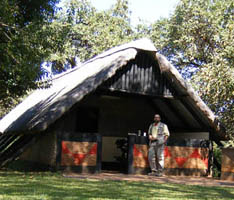 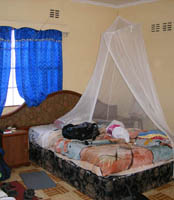
|
Food
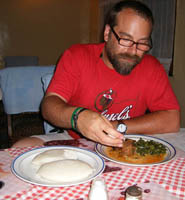 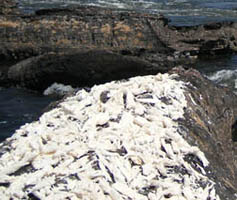
For the most part, since we were not camping, we ate at the lodges and guest houses were we kept rooms. For most meals, Alex and I ate with our hands (Zambian-style), and the meal almost always included nshima (corn "miellie" meal) with a sauce and rape leaves. In northern Zambia, like in Congo, people eat cassava. In many places we saw cassava trees planted in neat rows and the harvested, white cassava roots set out to dry, as in the picture above. Whereas nshima is a delight, cassava is not very appealing.
On our way south from Lusaka to Siavonga (and on the way back), we stopped at a stand offering roasted goat. Fantastic!
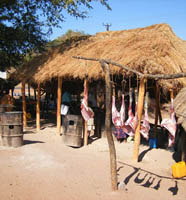 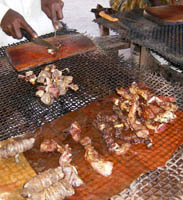
|
Collecting Mollusks
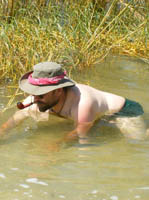 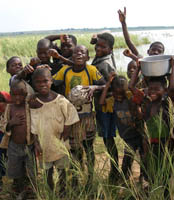 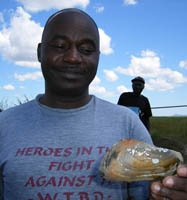
The primary objective the 2007 Zambia Expedition was to collect freshwater mussels. To do so, it was occasionally necessary to get in the water and risk becoming prey to both predators and parasites. More often, we received eager assistance from locals that were more than willing to trade kwachas (the Zambian currency) for mussels. By our own "pollywogging" and through such subcontracting, we were generally quite successful.
Once the specimens were in hand, a considerable amount of time was spent processing them. Plastic baggies are an important tool in freshwater malacology. When we captured live specimens, their soft-tissue was biopsied for molecular work, and all specimens need to be scrubbed completely clean for shipping.
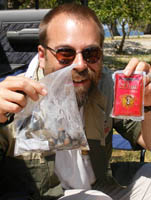 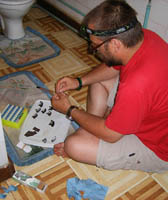 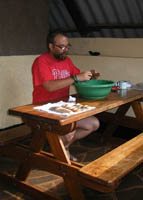
|
|